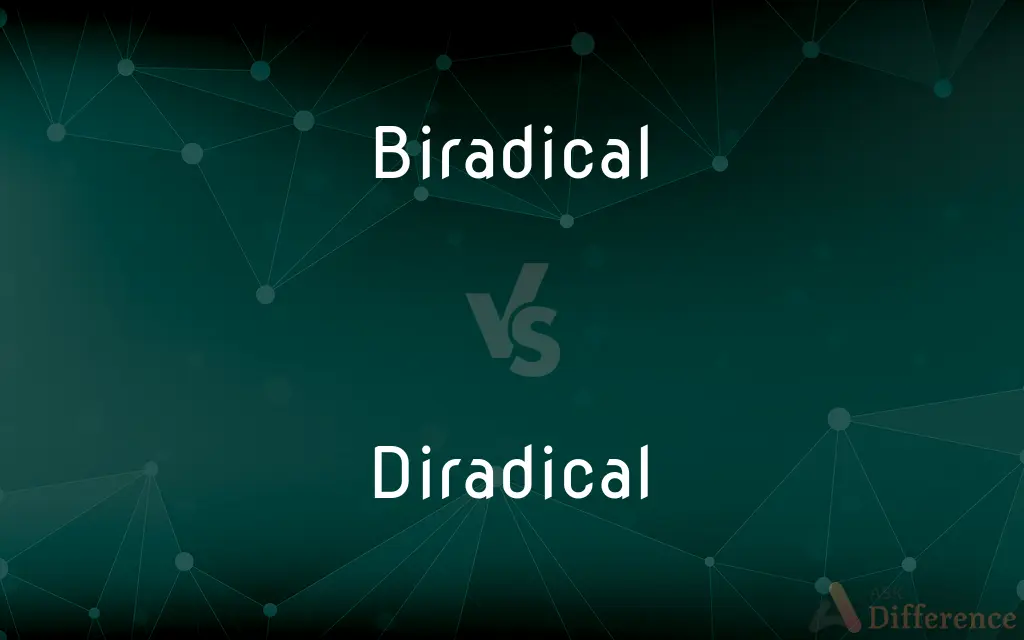Biradical vs. Diradical — What's the Difference?
By Maham Liaqat & Fiza Rafique — Updated on April 26, 2024
Biradicals contain two unpaired electrons localized on the same or different atoms, while diradicals specifically refer to molecules with two separate radical centers.

Difference Between Biradical and Diradical
Table of Contents
ADVERTISEMENT
Key Differences
Biradicals are chemical species characterized by the presence of two unpaired electrons, which can be either localized or delocalized across the molecule. On the other hand, diradicals are a subset of biradicals where the unpaired electrons are clearly localized on two distinct atoms or groups within the molecule.
The electronic configuration in biradicals allows for unique magnetic properties and reactive behavior due to their unpaired electrons. Whereas diradicals often exhibit even more pronounced reactivity and distinct magnetic properties because the separate radical centers can interact in complex ways.
Stability in biradicals varies widely; some are highly reactive and short-lived, while others might exist in a more stable form depending on the molecular structure and environment. Diradicals, however, tend to be more unstable due to the enhanced reactivity from the interaction between two radical centers.
Biradicals are important in various chemical reactions and mechanisms, such as in polymerization and enzyme catalysis. Diradicals, in contrast, are crucial in certain specific reactions, including those involving organic synthesis and photochemical processes.
Research on biradicals has led to discoveries in materials science and quantum chemistry, highlighting their role in conducting polymers and molecular electronics. Diradicals are studied intensively in the field of organic electronics, especially for their potential in developing novel organic semiconductors.
ADVERTISEMENT
Comparison Chart
Definition
Molecules with two unpaired electrons.
Molecules with two separate radical centers.
Electron Localization
Electrons may be localized or delocalized.
Electrons are clearly localized separately.
Stability
Stability varies; can be more stable.
Generally less stable due to radical interaction.
Common Usage
Found in polymerization, enzyme catalysis.
Used in organic synthesis, photochemistry.
Research Applications
Used in materials science, quantum chemistry.
Important in organic electronics.
Compare with Definitions
Biradical
Molecule with two unpaired electrons.
The oxygen molecule, O2, is a common example of a biradical with two unpaired electrons.
Diradical
Molecule with two separate radical centers.
Methlenetriphenylphosphorane is a diradical with distinct radical centers on carbon atoms.
Biradical
Can exhibit paramagnetic properties.
Biradicals are often paramagnetic because their unpaired electrons align with magnetic fields.
Diradical
Role in advanced materials development.
Diradicals are explored for creating advanced materials with unique magnetic and conductive properties.
Biradical
Reactivity depends on electron arrangement.
The reactivity of biradicals can change drastically with different electron delocalizations.
Diradical
Studied for electronic properties.
Research on diradicals focuses on their potential use in organic electronic devices.
Biradical
May participate in radical reactions.
Biradicals often act as intermediates in radical reactions, leading to various products.
Diradical
Highly reactive and often unstable.
Diradicals can quickly react with themselves or other molecules due to their instability.
Biradical
Found in a variety of chemical environments.
Biradicals appear in both biological systems and synthetic materials.
Diradical
Specific in organic synthesis reactions.
Diradicals are essential for some types of organic synthesis, providing unique pathways for reactions.
Biradical
(chemistry) any molecule having two independent radical centres
Diradical
A diradical in organic chemistry is a molecular species with two electrons occupying degenerate molecular orbitals (MO). The term "diradical" is mainly used to describe organic compounds, where most diradical are extremely reactive and in fact rarely isolated.
Biradical
A word or root in a Semitic language which consists of two consonants in its root formula.
Diradical
(chemistry) A divalent radical
Biradical
(said of words in Semitic languages) which consists of two consonants in its root formula.
Diradical
(organic chemistry) A free radical having a two unpaired electrons
Common Curiosities
What is a biradical?
A biradical is a molecule with two unpaired electrons, which may be localized or delocalized.
What makes diradicals significant in organic electronics?
Diradicals are studied for their unique properties that are useful in developing organic semiconductors and other electronic materials.
How do biradicals differ in stability from diradicals?
Biradicals can be more stable depending on electron delocalization, while diradicals are generally less stable due to interactions between separate radical centers.
Are there any safety concerns associated with handling diradicals?
Yes, due to their high reactivity and instability, diradicals must be handled under specific conditions to prevent unintended reactions.
What type of research is focused on diradicals?
Research on diradicals primarily concerns their application in organic synthesis, photochemistry, and materials science.
What are common uses of biradicals in industry?
Biradicals are used in polymerization processes, enzyme catalysis, and as intermediates in various chemical reactions.
Can biradicals be found in nature?
Yes, biradicals occur naturally in various biological and environmental processes.
What is a diradical?
A diradical is a type of biradical where the unpaired electrons are localized on two distinct atoms or groups.
How do biradicals and diradicals interact with magnetic fields?
Both types of radicals can align with magnetic fields, but their interactions vary based on the localization and orientation of the unpaired electrons.
How do the magnetic properties of biradicals and diradicals compare?
Both can exhibit paramagnetic properties, but diradicals often have more complex interactions due to their separate radical centers.
What are examples of materials developed using diradicals?
Materials such as organic conductors and specific types of polymers have been developed using the unique properties of diradicals.
How do biradicals affect chemical reactivity?
Biradicals can participate in or initiate radical reactions, affecting the course and products of chemical reactions.
Can diradicals be synthesized in the lab?
Yes, diradicals can be synthesized under controlled conditions, although maintaining their stability is challenging.
What is the role of diradicals in photochemical processes?
Diradicals can undergo specific reactions when exposed to light, making them important in photochemical applications.
How are biradicals detected and studied?
Biradicals are often detected and studied using techniques such as electron spin resonance (ESR) and magnetic resonance spectroscopy.
Share Your Discovery

Previous Comparison
Eprouvette vs. Mortar
Next Comparison
Halfwidth vs. AlphanumericAuthor Spotlight
Written by
Maham LiaqatCo-written by
Fiza RafiqueFiza Rafique is a skilled content writer at AskDifference.com, where she meticulously refines and enhances written pieces. Drawing from her vast editorial expertise, Fiza ensures clarity, accuracy, and precision in every article. Passionate about language, she continually seeks to elevate the quality of content for readers worldwide.
















































